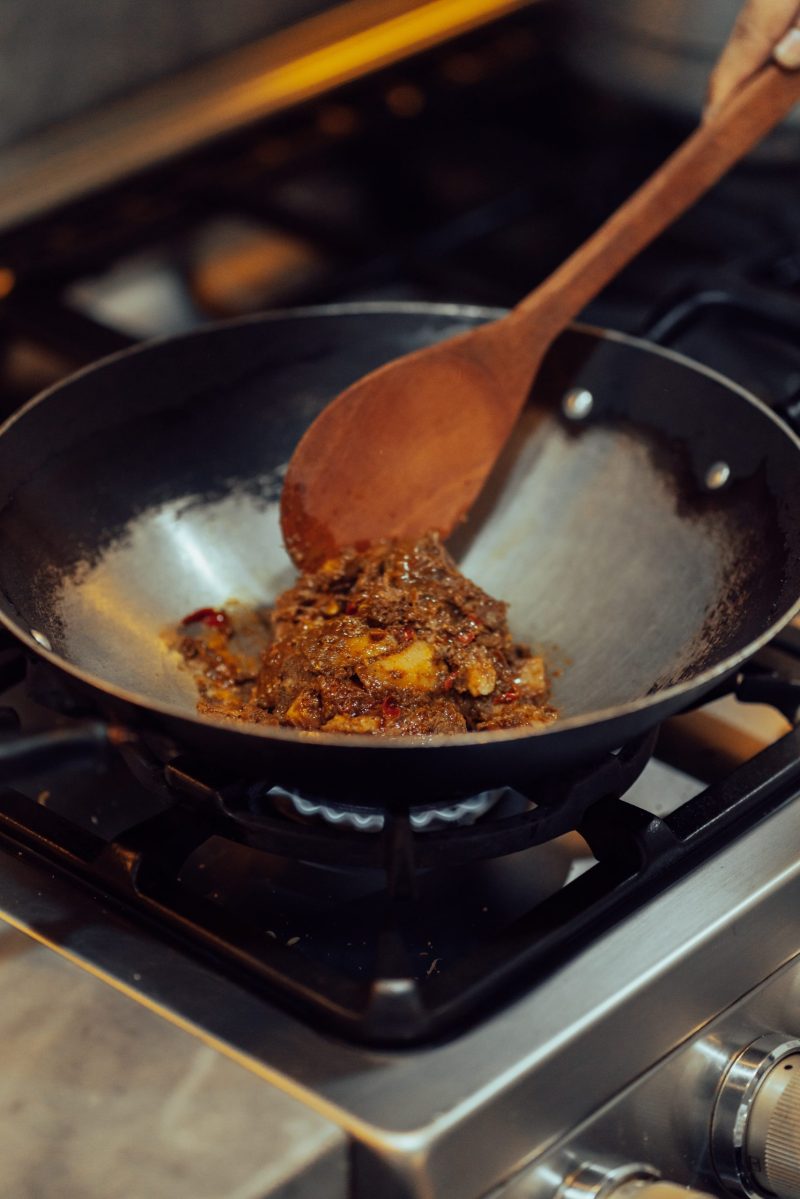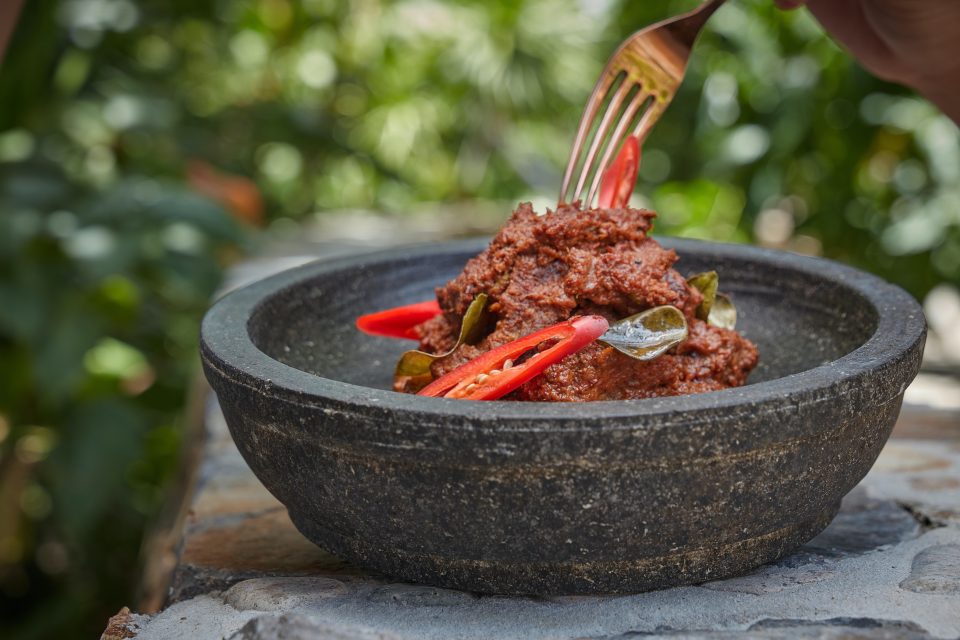Rendang is a meat dish from Minangkabau.
It is cooked using a low-temperature cooking method that takes four to five hours for the liquids to evaporate and the meat to turn dark brown and tender, becoming caramelised and infused with rich flavours from the usage of various spices and coconut milk.
At room temperature, rendang can last for weeks. Meanwhile, rendang cooked in a shorter time with the undried coconut milk is called kalio and has a bright brown colour.
The creation of rendang is a consequence of the process of acculturation coming into Minangkabau land. One culinary food similar to rendang resulting from acculturation is curry from India. Yevita Nurti, an anthropologist at Andalas University, said that the creation of dishes in West Sumatra – historically known as Minangkabau – especially rendang, is inseparably linked with the cultural sway of people paying a visit to Minangkabau land, some of whom were from India.
Nurti said that Minangkabau did receive a lot of influence in terms of spices since Indians and people from what is now Pakistan came to Minangkabau to seek out spices. Owing to the process of acculturation through marriage, the existing cooking spices began to spread and were modified by the Minang people, with rendang being one of the famous examples.
Yet Minang people do not consider rendang a mere dish; they also view it as their cultural identity. Viewed from its history, the existence and spread of rendang has something to do with the tradition of marantau or migrating. Minang people are noted for their wandering culture, leaving their hometowns of West Sumatra and making a living in newly migrated areas to survive. Those who are about to wander or migrate to new places would be equipped with rendang for its durability.
Being nomadic at that time didn’t come with the same luxuries and convenience we have today. In the past, Minang people got on a ship or buses for a few days to get to overseas lands. That is why they were equipped with rendang as provisions on the trip. In addition, the equipment used to cook rendang is the iron cauldron, indicating that the Minang people have been able to blacksmith for a long time.
Andalas University historian Prof. Dr Gusti Asnan opines that rendang became a widespread dish as the Minang people began to migrate and sail to Malacca to trade in the early 16th century. Rendang then became increasingly famous and widespread far beyond the region thanks to the Minangkabau migration culture. Besides working as employees or doing business overseas, many Minang people turned out to be entrepreneurs and established Padangnese restaurants throughout the archipelago, even extending to neighbouring countries in the Middle East and Europe, as well as to Australia and the US.
The restaurants widely introduced rendang and other Minangkabau dishes to the world. In 2011, rendang was crowned the Best Food in CNN’s World’s 50 Best Foods. Once again, in a later list published on 12th July 2017, rendang ranked number one. It was not a surprise, therefore, that a comment indicating how “non-crispy” rendang was cooked made by MasterChef UK judges John Torode and Gregg Wallace in 2018 angered many Indonesians.
In addition to traditional events, rendang has established itself as a favourite dish when processing the abundant sacrificial meat during the Eid al-Adha holiday and especially served for Eid al-Fitr. The West Sumatra provincial government also prioritises sending rendang as food aid to the country’s disaster-stricken areas.
 The second season of the National Geographic series Gordon Ramsay: Uncharted premiered on 7th June 2020, in which Ramsay noted that “Indonesian cuisine sometimes gets a little bit lost in translation, and they get sort of swallowed up into that sort of amazing backdrop. But until you come here, you don’t understand how individual it is — understand that there are over 200 variations of rendang — and how everything is localised. We don’t have dishes like that in the UK. We have Lancashire hotpot up north but then we don’t have 20 versions of it.”
The second season of the National Geographic series Gordon Ramsay: Uncharted premiered on 7th June 2020, in which Ramsay noted that “Indonesian cuisine sometimes gets a little bit lost in translation, and they get sort of swallowed up into that sort of amazing backdrop. But until you come here, you don’t understand how individual it is — understand that there are over 200 variations of rendang — and how everything is localised. We don’t have dishes like that in the UK. We have Lancashire hotpot up north but then we don’t have 20 versions of it.”
West Sumatra currently has two rendang cooking centres in two cities; Payakumbuh and Padang. The former has been recognised as the city of rendang in the province. The growth of rendang centres in the city has significantly improved compared to previous years, making the local SMEs see drastic growth.
The latter rendang centre is in Padang, the province capital, which was built on an area of 5,112 square metres. It has three blocks; block I is a place for rendang production, block II is a place for selling or promoting rendang-related products, and block III is the office. All SMEs are brought together in this place. This centre produces rendang meeting the standards of GMP, HACCP, and MD. Furthermore, the entire complement of rendang-related dishes are halal certified and comes with good packaging.
Adding to a specific place, anybody who travels to Padang city might find the recently famous shop that sells variations of rendang. An example is Rendang Asese located in two places, Jl. Thamrin No.14, Alang Laweh and Jl. Prof. Dr. Hamka No.363, Parupuk Tabing.
The writer is a lecturer in the Faculty of Humanities at Andalas University, Padang.




